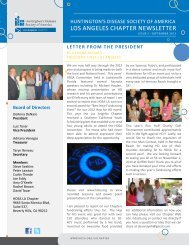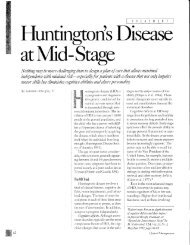Understanding Behavior in HD.final.8-18-05 - Huntington's Disease ...
Understanding Behavior in HD.final.8-18-05 - Huntington's Disease ...
Understanding Behavior in HD.final.8-18-05 - Huntington's Disease ...
Create successful ePaper yourself
Turn your PDF publications into a flip-book with our unique Google optimized e-Paper software.
26<br />
POSSIBLE CAUSES<br />
The frontal lobes are often referred to as the boss of the bra<strong>in</strong> and are responsible for executive functions.<br />
When the frontal lobes or their connections with the caudate are damaged, even simple tasks that we would<br />
normally take for granted can become difficult and frustrat<strong>in</strong>g.<br />
Before we proceed with some of the behaviors that can change due to frontal lobe disconnections, it might<br />
help to review our understand<strong>in</strong>g of bra<strong>in</strong> functions and circuits. Remember, a circuit is a pathway by which<br />
<strong>in</strong>formation travels <strong>in</strong> the bra<strong>in</strong>. Bra<strong>in</strong> circuits operate much like other circuits that we are familiar with <strong>in</strong> our<br />
daily lives (see pages 2-8).<br />
DEFINITION<br />
APATHY AND DIMINISHED ABILITY TO INITIATE ACTIVITIES<br />
A Problem with Initiation: Elsie’s Story<br />
Elsie did not have a problem with apathy. She still enjoyed and cared about many<br />
th<strong>in</strong>gs <strong>in</strong> her life. She was very disappo<strong>in</strong>ted, however, that she never did anyth<strong>in</strong>g anymore.<br />
She seemed to just sit around the house all day, sometimes never gett<strong>in</strong>g up<br />
from her easy chair except to use the toilet. After compla<strong>in</strong><strong>in</strong>g about her <strong>in</strong>activity to<br />
several others, <strong>in</strong>clud<strong>in</strong>g her family, it was agreed that the family would try to be Elsie’s<br />
“boss” and beg<strong>in</strong> activities for her. This strategy worked very well. Elsie was a good “follower”<br />
and enjoyed all of the activities that her family members encouraged her to<br />
attend or participate <strong>in</strong>. After about six weeks, however, it became evident that the family<br />
was experienc<strong>in</strong>g a significant amount of distress hav<strong>in</strong>g to guide and beg<strong>in</strong> every<br />
one of Elsie’s activities. First of all, the family was small. Secondly, all of the other family<br />
members had full-time commitments to work and/or school. They grew tired of provid<strong>in</strong>g<br />
constant <strong>in</strong>itiation for Elsie and began to neglect her. One day Elsie’s daughter<br />
came home from work with an abandoned puppy which had been left at school. At the<br />
family’s protest, Elsie adopted the puppy. The next time Elsie and her family were seen<br />
<strong>in</strong> support group, the whole family announced that the puppy had become Elsie’s<br />
“boss.” He <strong>in</strong>itiated playtime, d<strong>in</strong>nertime, time to go outside to the bathroom and time to<br />
go for a walk. Elsie was no longer <strong>in</strong>active!<br />
Apathy is similar to <strong>in</strong>attention, <strong>in</strong>difference and lethargy. Apathy is present when <strong>in</strong>dividuals with <strong>HD</strong><br />
seem to have dim<strong>in</strong>ished concern for th<strong>in</strong>gs about which they used to demonstrate a great deal of care and<br />
concern. A lack of <strong>in</strong>itiation often accompanies apathy but can also occur by itself <strong>in</strong> the absence of apathy.<br />
The ability to beg<strong>in</strong>, or <strong>in</strong>itiate, behaviors, conversation or activity is a very complex function which is<br />
frequently compromised <strong>in</strong> persons with various types of bra<strong>in</strong> dysfunction, <strong>in</strong>clud<strong>in</strong>g mild head <strong>in</strong>jury,<br />
Park<strong>in</strong>son disease, multiple sclerosis, stroke and, of course, <strong>HD</strong>.<br />
POSSIBLE CAUSES<br />
The circuits <strong>in</strong> the middle and bottom sections of the frontal lobes are very well-connected to the limbic<br />
system, or the “emotional lobe,” of the bra<strong>in</strong>. The caudate degeneration can result <strong>in</strong> disconnections <strong>in</strong> these<br />
circuits, caus<strong>in</strong>g the frontal lobe boss to be disconnected from the “feel<strong>in</strong>gs” of the bra<strong>in</strong>.

















